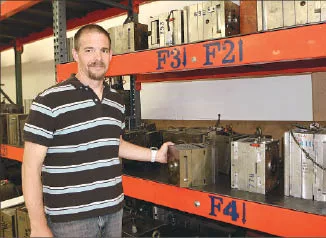Spokane Valley-based H&H Molds sees local orders pick up
H&H Molds' plastic injection work makes up bulk of revenues

Spokane Valley-based plastic mold maker and injection molding company H&H Molds Inc. says it expects to see its business, most of which is for other Inland Northwest manufacturers, pick up noticeably this year and into the coming years.
Established here in 1952, the company is based in a 24,000-square-foot manufacturing and distribution facility at 119 S. Adams, just off of Sprague Avenue. The company is owned by Jinelle Hogan, of Spokane, and it employs about 50 people. That number has remained mostly steady over the last several years, says company sales manager Mike Winnett.
Winnett says H&H Molds has seen its sales slowly increase during that time, and he adds that he foresees around 3 percent growth in sales this year.
"As the economy starts to recover, we are seeing some new opportunities with projects, and customers are opening up with their money," Winnett says. "We do see growth coming up in the near future."
Because the company makes for other manufacturers both molds to make plastic parts and the plastic parts from those molds, its sales growth depends on the economic health of those customers, he says.
One of H&H's largest customers here is Post Falls-based Buck Knives, for which the company molds knife handles and then attaches those handles to the blade, Winnett says.
Among the industries H&H Molds serves are electronics, telecommunications, medical, military, and food, he says. Some large Spokane-area companies it serves include Telect Inc. and Itron Inc., both of Liberty Lake. Winnett says Billings, Mont.-based Dixon Pumps Inc. is another big-order customer.
He says H&H Molds makes electronic housing components used by those companies in their products, among other plastic parts. It also gets a large number of orders from medical and pharmaceutical companies, he says, such as to make plastic specimen trays and cups.
Another application of the company's technology, he says, is to make plastic pieces used in military flak jackets.
Aside from the manufacturing of plastic molds and the injection molding services it offers, H&H Molds has the capabilities to complete small-scale metal fabrication orders, Winnett says.
The molds the company uses to make customers' plastic parts are made of steel, and he says the process to make a plastic injection mold starts with an electronic data file of the actual part that's to be molded.
Then, using reverse engineering, H&H Molds' technicians are able to program what the mold needs to look like to form the customer's part, Winnett says.
"The mold looks like the opposite of what the part is going to be," he says, adding that it can take between four and 15 weeks to engineer and machine a mold.
Winnett says the mold-making side of the company's operations is labor intensive, and the same group of employees will work on a single mold from start to finish until it's done. Usually the company is working on more than one mold at a time, because much of that process is machine automated.
Most of the molds that H&H Molds makes, Winnett says, are for customers' parts that are expected to be in ongoing production for an extended time period.
"Molds are expensive to build, even though the plastic parts are cheap" to make, he says.
Once a mold for a customer has been made, he says, it's stored at H&H Molds's headquarters here so that when the customer places an order for more parts, the mold is easily accessible and there's no wait time for it to be transported. Winnett estimates the company has up to 600 customer molds in storage at its headquarters.
Those heavy, steel molds can range in size between about 5 inches by 8 inches and up to 2 feet by 3 feet, he says. Larger molds can weigh as much as several thousand pounds, he adds.
Most molds outlive the production life cycle of a part, Winnett says, because customers might update a part or discontinue the production of a product the part is used in.
The cost to have a mold engineered and machined by H&H Molds can range from around $5,000 to $500,000, depending on the size and dimensions of the plastic piece being formed in the mold, Winnett says.
While the mold manufacturing side of the company's operations is crucial to its business of injecting molten plastic into those molds to make parts for its customers, Winnett says the production of those plastic pieces makes up the majority of H&H Molds's overall revenue.
The company's production floor includes 18 machines that inject melted plastic into molds, and on any given day, Winnett estimates there are eight to 10 of those machines running at once, all producing different parts.
H&H Molds uses thousands of varieties of plastics with different chemical compositions to achieve customers' specifications for a product or part, he says. Additionally, Winnett says, the company can change the color of the plastic to almost any hue by using special dyes.
The production cycle time for a single plastic part ranges between 30 and 60 seconds, from the time the melted material is injected into the mold until it's is ejected out in hardened form, he says. The steel molds are built to have internal water lines that send cold water through the mold to quickly cool and set the plastic, he says.
Depending on the customer's need, the finished parts are trimmed off of what's called the runner and then are packaged to be shipped or go into a secondary finishing process, Winnett says.
The runner is a connecting section of plastic between individual parts that might all be formed at once in a mold. The purpose for the runner connection is to allow the injected plastic to "run" through the mold to reach each cavity of it that makes up the resulting pieces' shapes.
H&H Molds trims off that connecting piece of plastic between separate parts or areas of the part before shipping pieces to customers. Some of that leftover plastic from the manufacturing process is ground back down into small pellets and re-melted to go into the injection process a second time, he says.
If a customer requests that a part receive a secondary finishing or manufacturing process, Winnett says, H&H Molds also can handle those needs, such as gluing two separately molded pieces together, or installing a small metal component into a plastic piece.
Winnett says that an industry trend is he's seeing more customers opt for is using recycled plastic materials.
"We are growing in that regard, and also are seeing requests for greener, antimicrobial materials," he says. "Medical customers have higher product standards so they don't usually allow recycled materials, but consumer-based companies are leaning that way. It's cost-driven and it's cheaper to go that way."
He says the commodity price of raw plastics—most of which are purchased for manufacturing purposes in a small pellet form—ranges as low as 85 cents per pound for some material types and can be as high as $60 per pound for highly-engineered plastics.
Winnett says that one of his roles with the company is to ensure its growth while continuing to become leaner in its processes, reducing operating costs, and improving production and delivery of products.
"We want to get bigger and bring in new business to support the local companies as much as possible," he says. "That is always one of the main goals, and to continue to improve and help customers drive down costs while improving quality."
Related Articles

_c.webp?t=1763626051)


